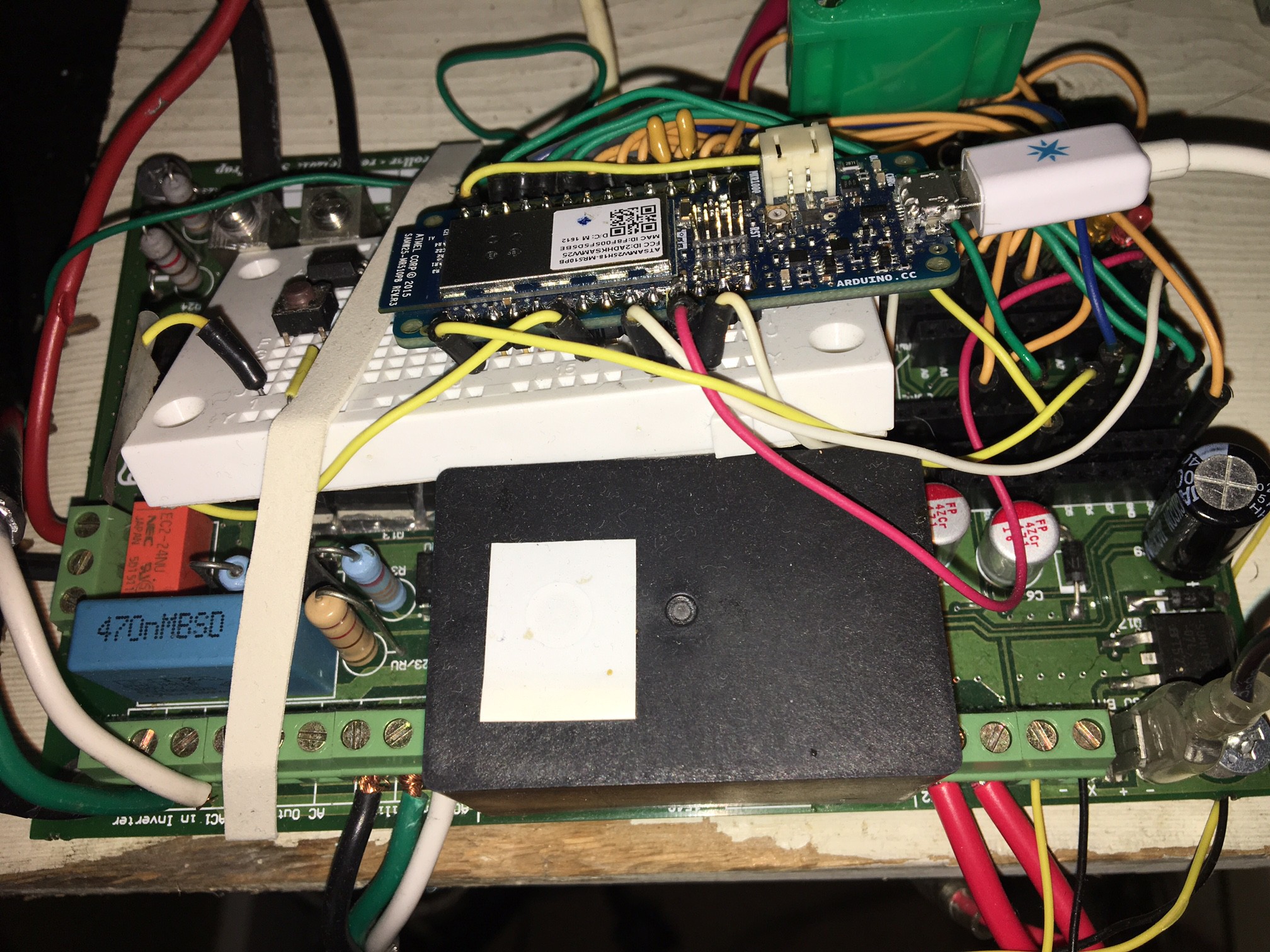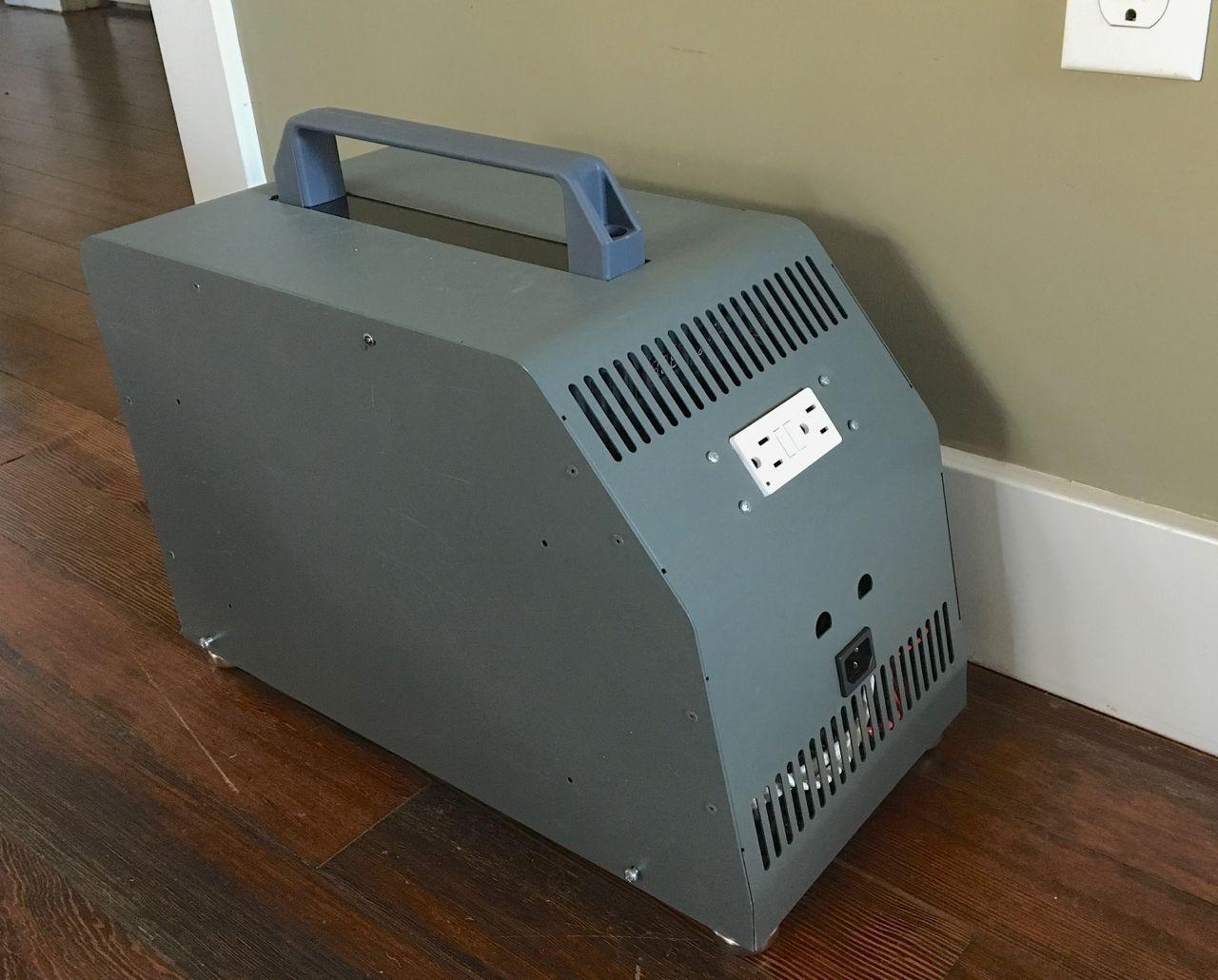[UPDATE] Now using MKR1000 to control the UNplug unit
I replaced the Particle Core with an Arduino MK1000 for several reasons:
- The pricing policy for a production run with more than 25 units is locking the user into a monthly subscription to access to the cloud gateway.
- Over-The-Air (OTA) software updates are awesome but having limited control over when this is actually happening was too scary. I had several incidents when the unit was doing an OTA that I did not trigger. Also debugging was very hard. It's a large library that does many things in the background and for this kind of devices it felt too 'big'
I have posted a picture of the current 'wiring' at the bottom: It looks chaotic but the MKR1000 is not pin compatible to the Nano and I had to wire the pins manually. There is an ugly pitfall with the supply voltage of the MRK1000: The Vin pin is not filtered except a tiny cap to GND. It is impossible to find any power supply that is quiet enough to provide conditions where the ADC converter would create stable precise readings. I looked at the schematics and found a complex filter being applied to the USB +5V input. You can realistically only use that path to supply power. Also the on-board Vin voltage regulator only supports 5.5V and not 6V as mentioned on the aspects page.
 Rev.3 PCB with MKR1000
Rev.3 PCB with MKR1000
[UPDATE] New rev. 3 PCB is now the heart of the UNplug toolbox
Power plant in toolbox size: the new UNplug power generator can be carried around easily. This is the fully functional prototype - currently only the H4 solar connectors are still on order. I just got the green side panels but need to find the right screws first.

The new design includes:
1500W pure sine wave inverter, sealed lead acid or lithium type batteries in a sturdy metal case with a total weight of 77 pounds. In full configuration this power generator is able to charge an electric vehicle via a level 1 charger! (with enough solar panels attached)
Capacity of the batteries are 0.8 - 1.2 kWh depending on the type. This is enough energy to power your fridge during the night.

I am using a separate power supply now because creating you own stable power supply for 24VDC from 120-240VAC is not easy or cheap. I am also having my own PWM charger for the solar panels (2 rows of mosfets) now. The inverter in this version will need to be one with a remote power-on function. I am also down to 6 cable lugs to make things lighter.
New and noteworthy items:
- 30A, 120/240VAC heavy duty relay
- external 40W switching power supply to charge the battery and power the unit at night
- 50A, 32V solar PWM charge controller built-in
Summary
I have developed a small 'box' that let you use solar energy in a very small scale. It powers just a few household items that run 24/7 like the refrigerator, internet modem, security system, laptop, etc.
It is modular, scalable, moveable and it connects any inverter, battery, charge controller, solar panel up to 1500W continuous power. It has wifi and hooks into Home Automation. It could also be labeled as Automatic Transfer Switch.
Project domain: http://one-fridge-off-the-grid.com
Hardware Design
I have gone from bread board proof of concept into actually manufacturing a small run of PCBs. Most of them are at friends houses who help beta-testing the system in combination with various inverters and charge controllers.
Here is the list of numbers explaining the components (red boxes in the second picture):
- 24VDC supply for external hardware with a max draw of 20Watt
- header pins to communicate with other hardware: Serial1 and I2C
- Connector for a Spark Core or Arduino Nano
- Buzzer
- Temperature sensor
- 120V to 24V transformer
- Heavy duty 6 AWG terminals to connect to Solar panel, charge controller, battery and inverter
- 120V DPDT relay to switch between 2 power sources which are connected at terminals 10
- Power mosfet bank to switch up to 50A at 30VDC
- Terminals for 10A at 120VAC
The current revision of the board is fitted to a standard enclosure from Polycase.com to make it easy to install.
Software Design
The basic functionality which was developed for Rev1 runs stable and has been ported to Rev2. This foundation code runs off-line and there is no interaction required. By switching to the Spark Core I entered the world of IoT which is very exciting but also poses some threats to the stability and reliability. I am currently working on a web page displaying live data coming from my unit.
I am not entirely sure how to make this unit immune to unwanted hacking. Since the beauty of Spark is the remote flashing of the firmware this is also on the other hand the biggest threat. If your power source is at risk you might feel direct impact on your quality of living.
Real-time solar power tracking
Here is a link to the website to access the live data. The graph shows the power generation (green) and consumption (red) for today and yesterday.Next steps
I am using the above setup to run my fridge, TV, stereo, laptops and chargers from solar energy and its running stable for more than a year now. I am now working on setting up a crowd-funding campaign which is a completely different set of problems. I also need to look into UL certification because it hooks into the 120V wall outlet in your room and it seems to be a requirement for hardware projects.
I will update this page on a regular basis. If you are interested you can take a look at my project blog called 'One Fridge off the Grid'.
Project Photos
 Above is the 'mobile' setup which we used at Burning Man to power our camp. The white box in the upper right is the rev 1 controller in a 3D printed case. The generator was only used 2x for powering a large water heater - for preparing gallons of hot tea :)
Above is the 'mobile' setup which we used at Burning Man to power our camp. The white box in the upper right is the rev 1 controller in a 3D printed case. The generator was only used 2x for powering a large water heater - for preparing gallons of hot tea :)
 This is the rev 1 controller - after returning from Burning Man. A bit dusty but it survived rain and 122F heat! The chip (ATmega2560) was directly soldered onto the PCB.
This is the rev 1 controller - after returning from Burning Man. A bit dusty but it survived rain and 122F heat! The chip (ATmega2560) was directly soldered onto the PCB.
 This is my current setup which resides in my kitchen. The controller does not sit in the 'fitted' case yet. It powers these items:
This is my current setup which resides in my kitchen. The controller does not sit in the 'fitted' case yet. It powers these items:
- Refrigerator
- TV, DVD, etc.
- Stereo
- Phones, tablets and other small chargers
- Laptops, printer, desk-lamp
- Cable modem, IP phone
Next Steps
I want to start my own crowd funding campaign to be able to produce this controller for a lot less money. My goal is to replace one coal power plant by taking one million fridges off the grid.
I am currently working with a producer to get a script written and a video filmed.
[UPDATE 7/11/15]
So the crowd funding campaign did not get the desired funding (only 11%) but I got lots of requests and contacts. This made me rethink the financing method and I am now trying to raise venture capital.
I am also working on rev3 of the PCB to offer 120V and 240V on the same board. As soon as I am receiving the new PCB I will post pictures.
Stay tuned !
 Markus Loeffler
Markus Loeffler